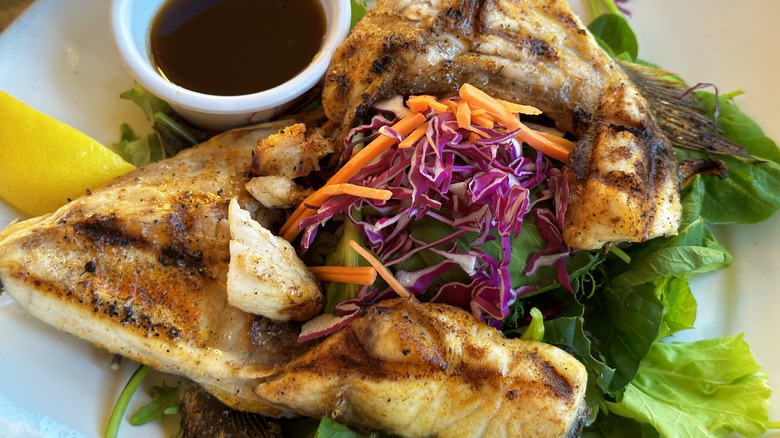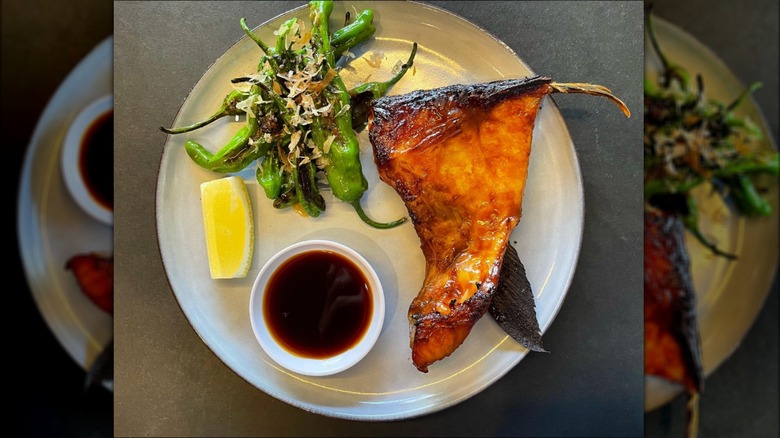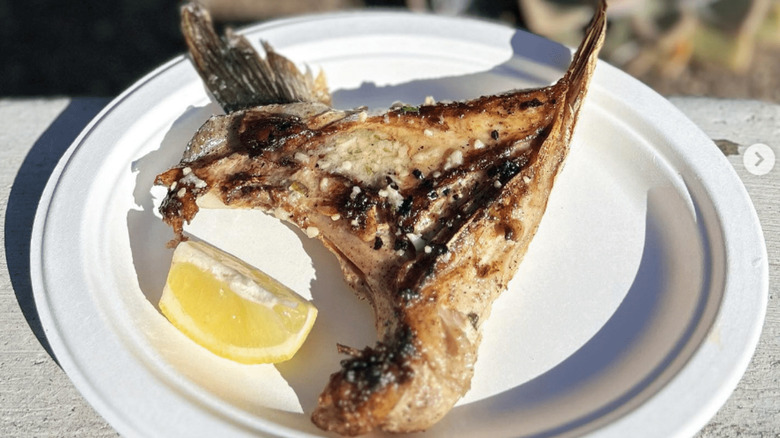Tuna Collar: The Underrated Cut Of Fish You Need To Grill
Say your friends say "pretty please" to tacking some tuna onto the menu for the backyard barbecue party that's on this weekend — what's the first cut of this super-delish fish that you immediately think of grilling? Nine times out of ten, you'd be thinking of a tuna steak. Either grilled as it is or cubed into tuna kebabs, it's a popular choice for a good reason — often cut from the fish's loins, it's meaty and packed to the literal gills with flavor. But if tuna steaks are stretching your budget a little, here's a tasty alternative worth trying: Tuna collar.
Admittedly, if you ask your local fishmonger about this cut, there might be some raised eyebrows and questions on why you'd even want it. In the United States, the collar is often thrown away along with parts like the bug-eyed head. Don't be too bothered by that and get it anyway — trust, it's actually one of the best parts of the fish for grilling.
Beneath the slimy skin of a tuna collar is a treasure trove of rich, fatty meat that can melt on your tongue once properly seared on a grill. The heat melts the fat, infusing the meat with an incredible depth of flavor. You'll get the full impact of tuna's unique taste, enhanced by the smoky notes from the charcoal and any marinade you've used. You'll soon forget about your prized tuna steaks altogether!
What really is a tuna collar?
A tuna collar is a triangular-shaped cut from the area just behind the fish's gills. Sometimes you might even get a whole fin attached, and you can leave it on as a decorative piece or cut it out. The flesh is attached to a big collarbone, which can be a bit awkward to deal with at first. But the good news is that it has none of the tiny, sharp bones that you have to pick out from some other fish cuts before tucking in.
A tuna collar is not a common sight in regular fish markets in America. You'll have better luck asking around at Asian fish markets, where it's considered a delicacy, especially in Japanese cuisine. Another option is to give your go-to fishmonger a call and ask them to set aside a collar the next time they get a fresh tuna. All the effort is worth it, as this cut is often much cheaper than the more popular filets — a 1.5-pound-plus tuna collar could cost as little as $25 – while being just as tasty.
Just keep in mind that tuna collars are typically sold by the piece rather than by weight. Don't be surprised if you're handed a 2 or 4-pound piece of frozen fish to haul back home if you do manage to find a fresh tuna collar for sale.
How to grill a tuna collar
If you're a novice griller, the good news is that the tuna collar is incredibly forgiving to cook. Unlike leaner cuts that can quickly become dry and chalky, the collar's higher fat content keeps the meat moist and flavorful as it sizzles on the grill.
There are a lot of marinade and glaze options for you to choose from, but for your first rodeo with this new cut, it's best to keep it simple. Start by patting the collar dry and generously seasoning it with salt and pepper. That's all you really need to do for a flavorful first tuna collar. Fire up your grill to medium-high heat (about 375 to 450 degrees Fahrenheit). While the grill heats up, lightly oil the grates. When the grill's up to heat, sear the tuna collar for about 5 minutes on each side over direct heat. You'll know it's ready when you see those beautiful grill marks appearing on the tuna's skin and when the meat flakes off easily if you poke it with a fork.
While a grilled tuna collar is delicious on its own, try serving it with a small dish of soy sauce on the side. It's a simple addition, but it'll give you a taste of why it's a common dish in Japan. The savory sauce just complements the rich-tasting tuna perfectly!


